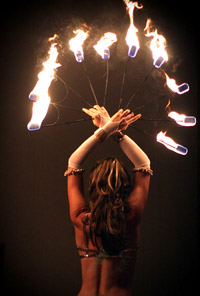 |
| Image from firegroove.com |
Fire spinning (otherwise known as "fire dancing" or perhaps more accurately, "fire performance") is a performance art that involves the manipulation of objects on fire. Its page on Wikipedia is relatively informative, especially if you are looking for broad coverage of all the elements. In fire spinning, the object of the performer's choice is made of metal, with thick (usually more than 1') Kevlar wicks. The wicks are dipped in fuel (David and my friends and I use white campfire gas, usually used found in sporting goods' stores).
The following are different elements of fire spinning or fire performance (this is not a complete list):
Fire fans are made of welded metal with the Kevlar wicks, and come in a varying range of sizes and shapes. Unlike some of the other fire spinning disciplines, fire fan spinning is closely associated with dance, rather than sport or tech. Granted, there is a rather large technical aspect to fan spinning (a lot of it is based on handling and grip techniques) but fan spinning is a lot like fan dancing or belly-dancing, which is what drew me to it in the beginning. I love the fluid movements and the dance -- I used to take dance and figure skating lessons as a teenager, and that was a big part of my life. I love expressing myself through dance.
A lot of fire-spinning techniques are largely technically based, rather than dance. Fire staff (link to a terrible Wikipedia page) involves a metal staff with two large Kevlar wicks at each end and (usually) a soft grip in the middle. Staff involves a lot of turning, contact motion, and tosses. David's forte is fire staff, and his signature move involves bouncing the staff off of one knee, over his head, and catching it behind his back.
Fire hoop is pretty much exactly what it sounds like -- hula-hooping (or just hooping) with a metal hoop, from which extend spokes and Kevlar wicks. Hooping employs both technical and dance elements.
Fire poi are two large wicks at the bottom of metal chains (in varying lengths, according to the height of the performer) that have small finger holes. Fire poi are easily one of the most dramatic mediums for fire spinning, and have the least amount of performer control, since the chains allow the lighted wicks to go in all directions. Poi spinning is another medium that, like fan spinning, utilizes dance.
Fire torches are small pins, almost like juggling pins, with Kevlar wicks. They are juggled or used in other fire performance skills, such as fire eating or fire breathing.
There are two people involved in a fire spinning performance. One, obviously, is the performer. The other is called a "safety". The safety stands nearby with a 2' x 2' (or about that size) piece of fire-retardant cloth. David and I use a piece of Duvetyne, which is 100% cotton treated to be flame-retardant. Frequently during spinning, the performer may miss a toss, or misjudge the distance between the flames and his hair/clothing/skin/etc. The safety's job is to ensure that the performer does not catch on fire.
If at any point, the performer catches on fire, the safety's job is to shout "DOWN" (not "fire", because hey, obviously things are on fire) and then to pat out the flame with the cloth. If the performer chooses to end his or her performance before the flames on the object burn out, the safety may also wrap the object with the cloth to extinguish the flames manually. (I will be doing a post going more into fire safety in another post)
If at any point, the performer catches on fire, the safety's job is to shout "DOWN" (not "fire", because hey, obviously things are on fire) and then to pat out the flame with the cloth. If the performer chooses to end his or her performance before the flames on the object burn out, the safety may also wrap the object with the cloth to extinguish the flames manually. (I will be doing a post going more into fire safety in another post)
For those people who have said, on my FB wall, that "I could never do that" or "I would set myself/my dog/my house/my neighborhood on fire" -- if I can do it, you can. I promise you. I'm about as uncoordinated a human being as they come. As David assured one of our friends last night -- it is not easy for the fire to catch and actually burn you. We have a friend who has been doing poi spinning for 10 years, and he has never lit himself on fire to the point of injuring himself. So if you are interested in fire spinning, and you're afraid of burning yourself -- please don't let that stop you. Join a class, find some friends who are trained, have a good safety, and have fun!
No comments:
Post a Comment